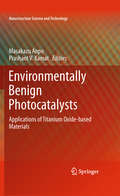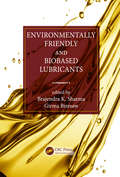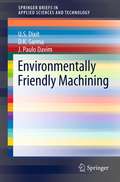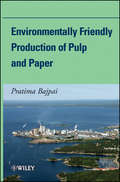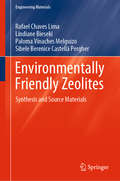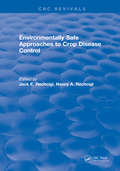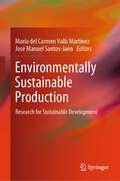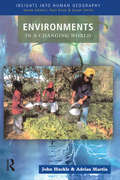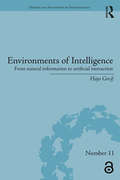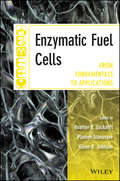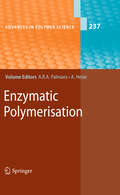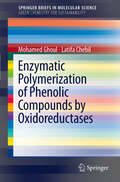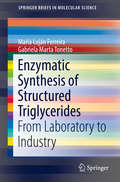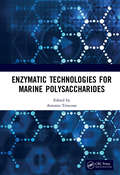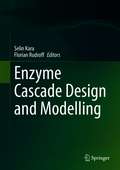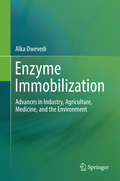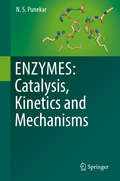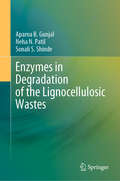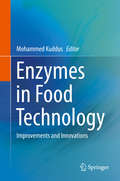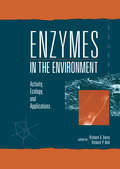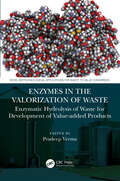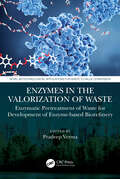- Table View
- List View
Environmentally Benign Photocatalysts
by Masakazu Anpo Prashant V. KamatTitanium oxide-based catalysts are especially promising as one of the most stable, non toxic, easily available photofunctional materials known today. Previously, the successful development of second-generation titanium oxide photocatalysts using an advanced metal ion-implantation technique led to reactions that could be induced not only with UV but also visible light. Since then, not only has efficiency been improved but new materials and synthesis methods have also been developed. This book will cover the various approaches in the design of efficient titanium oxide-based photocatalysts by such methods as sol-gel, precipitation, dip-coating, metal implantation and sputtering deposition. It will cover the most recent advances in TiO2 research and their potential applications as well as detailed and fundamental characterization studies on the active sites and mechanisms behind the reactions at the molecular level. The book should serve not only as a text for research into photochemistry and photocatalysis but also to inspire more applications into environmentally-harmonious technologies.
Environmentally Friendly and Biobased Lubricants
by Brajendra K. Sharma and Girma BiresawA Comprehensive Review of Developing Environmentally Friendly Lubricants A push from environmentally savvy consumers along with recent changes in governmental regulations have paved the way for a marketplace of products with high levels of environmental performance. Fueled by the growing demand for biobased lubricants, Environmentally Friendly and Biobased Lubricants highlights the development of environmentally friendly additives that are compatible with environmental regulations and describes the approaches being used in this emerging area. Derived from research topics shared over the years at various technical sessions of the Society of Tribologists and Lubrication Engineers (STLE) Annual Meetings, the book includes a critical assessment of gaps and weaknesses in the field of environmentally friendly fluids and biobased lubricants. Each chapter is written by authors selected from the environmentally friendly fluids and biobased lubricants sessions of STLE and also incorporates input from prominent researchers invited to take part in the book. Expert contributors discuss the control, production, usage, and disposal of lubricants; factor in related policies, laws, and regulations around the world; and include case studies demonstrating the uses and values of commercially viable biobased lubricants. The book is divided into five sections that cover advanced environmentally friendly base oils and feedstocks, biobased hydraulic lubricants and biodegradability, chemically/enzymatically modified environmentally friendly base oils, vegetable oil–based environmentally friendly fluids, and additives for environmentally friendly fluids.
Environmentally Friendly Machining
by U. S. Dixit J. Paulo Davim D. K. SarmaEnvironment-Friendly Machining provides an in-depth overview of environmentally-friendly machining processes, covering numerous different types of machining in order to identify which practice is the most environmentally sustainable. The book discusses three systems at length: machining with minimal cutting fluid, air-cooled machining and dry machining. Also covered is a way to conserve energy during machining processes, along with useful data and detailed descriptions for developing and utilizing the most efficient modern machining tools. Researchers and engineers looking for sustainable machining solutions will find Environment-Friendly Machining to be a useful volume.
Environmentally Friendly Production of Pulp and Paper
by Pratima BajpaiImplementing Cleaner Production in the pulp and paper industryThe large--and still growing--pulp and paper industry is a capital- and resource-intensive industry that contributes to many environmental problems, including global warming, human toxicity, ecotoxicity, photochemical oxidation, acidification, nutrification, and solid wastes. This important reference for professionals in the pulp and paper industry details how to improve manufacturing processes that not only cut down on the emission of pollutants but also increase productivity and decrease costs.Environmentally Friendly Production of Pulp and Paper guides professionals in the pulp and paper industry to implement the internationally recognized process of Cleaner Production (CP). It provides updated information on CP measures in:Raw material storage and preparationPulping processes (Kraft, Sulphite, and Mechanical)Bleaching, recovery, and papermakingEmission treatment and recycled fiber processingIn addition, the book includes a discussion on recent cleaner technologies and their implementation status and benefits in the pulp and paper industry.Covering every aspect of pulping and papermaking essential to the subject of reducing pollution, this is a must-have for paper and bioprocess engineers, environmental engineers, and corporations in the forest products industry.
Environmentally Friendly Zeolites: Synthesis and Source Materials (Engineering Materials)
by Rafael Chaves Lima Paloma Vinaches Melguizo Sibele Berenice Castellã Pergher Lindiane BiesekiThis book details zeolites, their structures and the parameters that influence their synthesis, providing a new and actual perspective of this field. Following this, the authors show different processes used to synthesize zeolites using residues, natural materials, and other eco-friendly materials such as raw powder glass, clays, aluminum cans, diatomites, rice ashes or coal ashes. Finally, this book gives the reader a wide range of different synthesis methods that they can be applied to several industrial processes.
Environmentally Safe Approaches to Crop Disease Control (Agriculture And Environment Ser.)
by Jack E. RechciglThe use of chemicals in agriculture and home gardens has become an area of concern due to improper use and negative environmental effects. Environmentally Safe Approaches to Crop Disease Control addresses alternative approaches for managing crop diseases. It gives a balanced overview of state-of-the-art environmentally safe approaches to crop disease control and discusses the latest trends.
Environmentally Sustainable Production: Research for Sustainable Development
by María del Carmen Valls Martínez José Manuel Santos-JaénIn this book, world-leading researchers in corporate sustainability explore the importance of considering environmental, social, and governance criteria to ensure the survival and profitability of a company, as well as the protection of people and the planet. The book serves as a resource for company executives and managers seeking to implement sustainable practices, investors and shareholders interested in how companies address environmental and social challenges, students and academics studying issues related to sustainability and corporate social responsibility, consulting and advisory professionals, and sustainability activists and advocates seeking to learn more about how companies can be part of the solution to environmental and social problems. The authors provide a collection of chapters that rigorously address the contribution of business to sustainable development, making it a valuable resource for anyone looking to understand the importance of sustainability in business.
Environments in a Changing World (Insights Into Human Geography)
by John Huckle Adrian MartinWhile there is no shortage of of books on the environment there are few introductory texts that outline the social theory that informs human geographical approaches to the interactions between ecology and society. Students arriving at university often lack the understanding of history, economics, politics, sociology and philosophy that contemporary human geography requires. Environments in a Changing World addresses this deficit, providing foundation knowledge in a form that is accessible to first year students and applied to the understanding of both contemporary environmental issues and the challenge of sustainability. Students are challenged to develop and defend their own ethical and political positions on sustainability and respond to the need for new forms of ecological citizenship.
Environments of Intelligence: From natural information to artificial interaction (History and Philosophy of Technoscience)
by Hajo GreifWhat is the role of the environment, and of the information it provides, in cognition? More specifically, may there be a role for certain artefacts to play in this context? These are questions that motivate "4E" theories of cognition (as being embodied, embedded, extended, enactive). In his take on that family of views, Hajo Greif first defends and refines a concept of information as primarily natural, environmentally embedded in character, which had been eclipsed by information-processing views of cognition. He continues with an inquiry into the cognitive bearing of some artefacts that are sometimes referred to as 'intelligent environments'. Without necessarily having much to do with Artificial Intelligence, such artefacts may ultimately modify our informational environments. With respect to human cognition, the most notable effect of digital computers is not that they might be able, or become able, to think but that they alter the way we perceive, think and act. The Open Access version of this book, available at http://www.tandfebooks.com/doi/view/10.4324/9781315401867, has been made available under a Creative Commons CC-BY licence
Enzo Ferrari (Movie Tie-in Edition): The Man and the Machine
by Brock YatesThe sweeping biography of the enigmatic racer and sports car mogul who built the Ferrari brand—the inspiration for the major motion picture Ferrari directed by Michael Mann—featuring a new foreword, epilogue, and photo insertGenius? Tyrant? Power broker? Enzo Ferrari is the impressively researched, fully detailed biography of one of the most powerful men of the twentieth century. Brock Yates penetrated Ferrari&’s inner circle and reveals everything, from his early days in the town of Modena to his bizarre relationship with his illegitimate son; from his fanatic passion for speed to his brilliant marketing of the famous Ferrari image; from his manipulative but enormously effective management tactics to his own frustrated dreams. Fast, fun, and scandalous, Enzo Ferrari more than lives up to its remarkable subject.
Enzymatic Fuel Cells
by Plamen B. Atanassov Heather R. Luckarift Glenn R. JohnsonSummarizes research encompassing all of the aspects required to understand, fabricate and integrate enzymatic fuel cellsContributions span the fields of bio-electrochemistry and biological fuel cell researchTeaches the reader to optimize fuel cell performance to achieve long-term operation and realize commercial applicabilityIntroduces the reader to the scientific aspects of bioelectrochemistry including electrical wiring of enzymes and charge transfer in enzyme fuel cell electrodesCovers unique engineering problems of enzyme fuel cells such as design and optimization
Enzymatic Polymerisation
by Anja R. Palmans Andreas HeiseOxireductases in the Enzymatic Synthesis of Water-Soluble Conducting Polymers, by E. Ochoteco and D. Mecerreyes * Transferases in Polymer Chemistry, by J. van der Vlist and K. Loos * Hydrolases Part I: Enzyme Mechanism, Selectivity and Control in the Synthesis of Well-Defined Polymers, by M.A.J. Veld and A.R.A. Palmans * Hydrolases in Polymer Chemistry: Chemoenzymatic Approaches to Polymeric Materials, by A. Heise and A.R.A. Palmans * Hydrolases in Polymer Chemistry: Part III: Synthesis and Limited Surface Hydrolysis of Polyesters and Other Polymers, by G.M. Guebitz * Exploiting Biocatalysis in the Synthesis of Supramolecular Polymers, by S. Roy and R. V. Ulijn
Enzymatic polymerization of phenolic compounds by oxidoreductases
by Latifa Chebil Mohamed GhoulThe enzymatic polymerization of phenolic compounds has been generating interest in several fields such as food, cosmetics, and pharmaceuticals. These compounds are employed for their antioxidant properties; however, their use is limited by their low solubility and thermal stability. Polymerization can improve their solubility and their thermal stability though and create new properties which are dependent on the molecular mass and the structure of polymers. The reaction yield, the polydispersity, the molecular mass, the structure and the properties of synthesized polymers can be controlled by the mode of control of the reaction and by the reaction conditions. Enzymatic polymerization of phenolic compounds by oxidoreductases analyze the processes used and the key factors (temperature, solvent, origin of the enzyme, structure of the substrate, reactor design, ...) which control the polymerization of phenolic species by these oxidoreductase enzymes in order to obtain polymers with desired characteristics and properties.
Enzymatic Synthesis of Structured Triglycerides
by María Luján Ferreira Gabriela Marta TonettoThis brief presents the state of the art on enzymatic synthesis of structured triglycerides and diglycerides, focusing on glycerol as the substrate and covering interesterification of vegetable oils in one and two steps. It critically reviews the available literature on enzymatic and chemo-enzymatic synthesis of di- and triglycerides in one or more steps. The effects of the structure, length and unsaturation of the fatty acids are carefully considered, as well as the inhibitory potential of highly unsaturated complex fatty acid structures. The brief also addresses acyl migration and the use of adsorbents, taking into account the most recent literature and presenting the problem in an industrial context. It discusses experimental and analytical problems concerning, e.g. the lab scale and the scaling up to bench and pilot plants. Several examples are presented, and their successes and failures are assessed. Biocatalysts based on lipases are analyzed with regard to problems of immobilization, stability on storage time and activity after multiple uses. The need for specific Sn-2 lipases is presented and strategies for optimizing Sn-2 esterification are discussed. Lastly, practical aspects are examined, e.g. lipase “leaching” with loss of activity, taking into account the latest findings on continuous and batch reactor configurations and presenting the advantages and disadvantages of each.
Enzymatic Technologies for Marine Polysaccharides
by Antonio TrinconeThe bioactivity potential of marine polysaccharides has long been considered an underexploited aspect. These molecules found in seaweed, microalgae, bacteria, and animal fish (shellfish, mollusks, etc.) and the derived oligosaccharides need to be explored thoroughly with an interdisciplinary approach. They are an extraordinary source of chemical diversity, and the literature highlights many applicative fields, including the food industry, cosmetics, biomedicine, agriculture, environmental protection, wastewater management, etc. More recently, a new challenge has emerged: the exploitation of marine biomass as the source of sustainable energy to participate in the future replacement of fossil resources. Enzymatic Technologies for Marine Polysaccharides provides insight into the recent research developments of marine polysaccharides and their current and potential applications. The first section of the book explores the diversity of marine polysaccharides from various angles, including a description of the chemical complexity and current applications and new perspectives in food, pharmaceutical, cosmetics, and biomaterials offered by recent research. Efficient valorization of the marine polysaccharide biomass requires a rigorous analysis of the polysaccharides structure and their biological properties. The second section of the book concerns the development of extraction techniques and the improvement of the methods aimed at the characterization of their structure and function. Finally, the third and last section of the book articulates the enzymatic technologies from the discovery of novel enzymes to their production pipelines related to the fields of biorefinery, food, pharmaceutics, and other fine chemicals. Presents the latest research in marine oligosaccharides and polysaccharides Written by world-class researchers in marine enzyme technology Discusses the latest developments in extraction methods Presents a detailed overview of enzymatic routes for modification, production, and synthesis of marine oligosaccharides Contains extensive references at the end of each chapter to enhance further study
Enzyme-based Biosensors: Recent Advances and Applications in Healthcare
by Sanjukta Patra Debasree Kundu Manashjit GogoiThis book summarizes the principles, protocols, and applications of enzyme-based biosensors in healthcare. After providing a brief history and discussing the development of various biosensors used for medical applications, it explores the principles of enzyme-based biosensors and reviews a number of enzyme immobilization techniques. It then addresses the potential of enzyme-based biosensors in the diagnosis of infectious and non-infectious diseases; illustrates the potential of enzyme-based biosensors for non-invasive monitoring of biochemical biomarkers; and assesses the application of paper-based and microfluidic-based nanobiosensors in medical diagnostics. A one-stop resource on recent advances in enzyme-based biosensors in healthcare, this book will appeal to students, researchers and scientists in a range of disciplines, as well as entrepreneurs, and medical/healthcare professionals.
Enzyme Cascade Design and Modelling
by Selin Kara Florian RudroffThis book provides a comprehensive overview of the recent developments achieved in the field of chemo/enzymatic cascades with topics spanning from design (in vitro and in vivo) to kinetic- and process modelling as well as process control. Opportunities and challenges of building multi-step chemo/enzymatic reactions are discussed, whereby the latter are critically assessed in each chapter and methods to ease the implementation are explored. Both, multi-enzymatic cascades and chemo-enzymatic cascades are presented with the motivation of combining the strengths of these two worlds (e.g. selectivity, activity and robustness) not neglecting the obstacles and challenges of such endeavour. Furthermore, the use of non-conventional media for catalytic cascade reactions, recent achievements and potential for future developments in a technical environment are addressed.
Enzyme Immobilization
by Alka DwevediThis book covers the latest developments in enzyme immobilization with its wide applications, such as for industry, agriculture, medicine, and the environment. Topics covered include basics of enzyme immobilization, its implication in therapeutics and disease diagnostics, and its significance in solving environmental problems. This is an ideal book for researchers, graduate and postgraduate students, as well as scientists in industry, agriculture and health sectors. This book is a complete summary of enzyme immobilization and also thoroughly covers all the latest research. This book covers: The last one-hundred years of innovative research done in enzyme immobilization Recent developments in immobilization techniques, such as types of matrices, immobilization methods, and linking agents, as well as enzyme immobilization without any matrices and its propertiesThe physiological and industrial significance of enzymes from plants and the implementation of immobilized enzymes in the treatment of waste water and polluted air The physiological and industrial significance of enzymes from plants and the implementation of immobilized enzymes in the treatment of waste water and polluted air Biomedical and bioanalytical applications of immobilized enzymes
ENZYMES: Catalysis, Kinetics and Mechanisms
by N. S. PunekarThis enzymology textbook for graduate and advanced undergraduate students covers the syllabi of most universities where this subject is regularly taught. It focuses on the synchrony between the two broad mechanistic facets of enzymology: the chemical and the kinetic, and also highlights the synergy between enzyme structure and mechanism. Designed for self-study, it explains how to plan enzyme experiments and subsequently analyze the data collected. The book is divided into five major sections: 1] Introduction to enzymes, 2] Practical aspects, 3] Kinetic Mechanisms, 4] Chemical Mechanisms, and 5] Enzymology Frontiers. Individual concepts are treated as stand-alone chapters; readers can explore any single concept with minimal cross-referencing to the rest of the book. Further, complex approaches requiring specialized techniques and involved experimentation (beyond the reach of an average laboratory) are covered in theory with suitable references to guide readers. The book provides students, researchers and academics in the broad area of biology with a sound theoretical and practical knowledge of enzymes. It also caters to those who do not have a practicing enzymologist to teach them the subject.
Enzymes in Degradation of the Lignocellulosic Wastes
by Aparna B. Gunjal Neha N. Patil Sonali S. ShindeThis book offers valuable insights into the principles, mechanisms of action and applications of traditional and novel enzymes involved in the degradation of wastes. Enzymes are biological catalysts that play an important role in various biochemical reactions. The generation of value-added products by means of these biological processes is also discussed. This book covers the use of in silico and computational methods in understanding the biodegradation processes, and reveals the importance of enzymes in various biochemical reactions and kinetics. The book’s target audience includes undergraduate and graduate students, faculty members at colleges and universities, research students, scientists and industry professionals.
Enzymes in Food Technology: Improvements and Innovations
by Mohammed KuddusThe integration of enzymes in food processing is well known, and dedicated research is continually being pursued to address the global food crisis. This book provides a broad, up-to-date overview of the enzymes used in food technology. It discusses microbial, plant and animal enzymes in the context of their applications in the food sector; process of immobilization; thermal and operational stability; increased product specificity and specific activity; enzyme engineering; implementation of high-throughput techniques; screening of relatively unexplored environments; and development of more efficient enzymes. Offering a comprehensive reference resource on the most progressive field of food technology, this book is of interest to professionals, scientists and academics in the food and biotech industries.
Enzymes in Nonaqueous Solvents
by Evgeny N. VulfsonIn Enzymes in Nonaqueous Solvents: Methods and Protocols, leading chemists, biochemists, biotechnologists, and process engineers summarize for the first time a wide range of methods for executing enzymatic transformations under nonaqueous conditions. Each method includes detailed step-by-step instructions for its successful completion, a list of materials, and ancillary notes that explain the scientific basis of the procedure, as well as troubleshooting. Also provided are a generic description of key reactions, advice on biocatalyst preparation, discussion of reaction conditions, and instructions on bioreactor design. Comprehensive and state-of-the-art, Enzymes in Nonaqueous Solvents: Methods and Protocols offers today's synthetic chemists, biochemists, and process engineers all the essential information needed to carry out enzymatic reactions in nonaqueous media, as well as to successfully scale up to production quantities.
Enzymes in the Environment: Activity, Ecology, and Applications (Books In Soils, Plants, And The Environment Ser. #Vol. 86)
by Richard G. Burns Richard P. DickThe need to understand the biological processes that are important for essential aquatic and terrestrial ecosystem function has prompted much research into the field of ecological enzymology. This book presents the two broad areas of application in a compilation of reviews by 21 international experts in their respective fields. The first explores e
Enzymes in the Valorization of Waste: Enzymatic Hydrolysis of Waste for Development of Value-added Products (Novel Biotechnological Applications for Waste to Value Conversion)
by Pradeep VermaEnzymes play a vital role in the enzymatic hydrolysis of waste for its conversion to useful value-added products. Enzymatic Hydrolysis of Waste for Development of Value-added Products focusses on the role of key enzymes such as cellulase, hemicellulases, amylases, and auxiliary enzymes (LMPOs), used in the hydrolysis step of the biorefinery setup. Further, it discusses the role of enzymes in the generation of reducing sugars and value-added compounds, with major emphasis on recent advances in the field. The mechanism, importance, type, evolution, and role of enzymes in hydrolysis constitute the crux of this volume, which is illustrated with examples and pertinent case studies. Features: • Explores the role of hydrolyzing enzymes in the breakdown and transformation of biomass hydrolysis. • Discusses the potential of auxiliary enzymes (LPMOs) for enhancing hydrolysis potential. • Covers recent developments in the field of enzymatic-assisted hydrolysis of waste for conversion of waste to value-added products. • Deliberates all possible products that can be generated from enzymatic hydrolysis of waste and their potential utilization. • Elucidates the limitations and advantages of enzyme-based hydrolysis and possible strategies for moving from the laboratory to large scale industries. This book is aimed at graduate students, researchers and related industry professionals in biochemical engineering, environmental science, wastewater treatment, biotechnology, applied microbiology, biomass-based biorefinery, biochemistry, green chemistry, sustainable development, waste treatment, enzymology, microbial biotechnology, and waste valorization.
Enzymes in the Valorization of Waste: Enzymatic Pretreatment of Waste for Development of Enzyme-based Biorefinery (Novel Biotechnological Applications for Waste to Value Conversion)
by Pradeep Verma"Enzymes in Valorization of waste: Enzymatic pre-treatment of waste for development of enzyme based biorefinery" focusses on the role of key delignifying enzymes (Laccase, MnP, LiP and LPMO’s) involved in biomass pre-treatment. The role of these enzymes such as hemicellulose, chitinases, and pectinases are discussed exhaustively including enzyme assisted recovery of high value phenolic compounds and value-added compounds generated during the pre-treatment process. All chapters cover broad topics and thematic areas associated with the pre-treatment step of biorefinery including enzyme mediated water treatment and its associated applications in biofuels, biorefineries and bioconversion. Features: Highlights mechanistic approach how the enzyme being able to regulate the delignification. Discusses advantages of the enzymatic delignification over other physical and chemical methods. Illustrates role of enzymes such as pectinase and chitinases and breaking down of biomass recalcitrance due to presence of pectin and chitin. Consolidates details on de-lignifying enzymes ((Laccase, MnP, LiP and LPMO’s) suitable in biomass pretreatment. Explores role of delignifying enzymes in high value phenolic compounds recovery during the enzymatic delignification. This book aims at Graduate students, Researchers and related Industry Professionals in Biochemical Engineering, Environmental Science, Wastewater Treatment, Biotechnology, Applied Microbiology, Biomass Based Biorefinery, Biochemistry, Green Chemistry, Sustainable Development, Waste Treatment, Enzymology, Microbial Biotechnology, and Waste Valorization.
